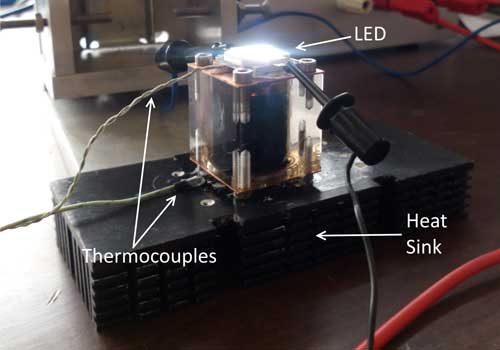| Posted: Dec 09, 2016 | |
An innovative magnetically activated thermal switch based on nanofluids |
|
| (Nanowerk Spotlight) With the exponential rise of power dissipation in electric devices such as integrated circuits or micro (MEMS) or nano-electromechanical systems (NEMS), new thermal management solutions are in high demand. | |
| Thermal switches, being devices capable of controlling the temperature flow between two surfaces, are one of the solutions capable of effectively tackling this problem. | |
| In new work, researchers demonstrate an innovative magnetically actuated thermal switch based on nanofluids capable of controlling both the magnitude and direction of the heat flux. This device takes advantage of the thermal conductivity increase in magnetic nanofluids when submitted to an applied magnetic field parallel to the temperature gradient. The increase of thermal conductivity and the movement of the nanofluid inside the thermal switch prototype reduces the temperature gradient across the device. | |
| This recent study, led by researchers from the Institute of Physics of Materials at the University of Porto (IFIMUP) and a member of the National Associate Laboratory Institute of Nanoscience and Nanotechnology (IN), has been published in Nano Energy ("Novel thermal switch based on magnetic nanofluids with remote activation") | |
 |
|
| Proof of concept to demonstrate the applicability of this thermal switch: Image of the MATS with a 10 W LED heat source at the top surface and a heat sink at the bottom surface. The LED operating temperature was lowered by 17°C through the action of the thermal switch." (Image: J. H. Belo, IFIMUP-IN, Universidade do Porto) (click on image to enlarge) | |
| The magnetically actuated thermal switch is composed of a thermal insulator body with two thermally conductive windows at the top and bottom. This forms a closed container where the magnetic nanofluid is confined. | |
| The device has two operating states (ON and OFF) depending whether heat is being transported between the two windows or not. | |
| In the OFF state no magnetic field is applied and the magnetic nanofluid remains at the bottom of the insulator cage (heat source). | |
| When an external magnetic field is applied (ON state), the magnetic nanofluid moves from the bottom of the insulator cage to the top surface, carrying the heat absorbed from the heat source and releasing it at the heat sink. | |
| The researchers built two prototypes with different heights between the top and bottom (3 cm and 1 cm). Both devices were tested for a range of magnetic field frequencies between 0.01 and 30 Hz with an initial temperature gradient of approximately 35°C. | |
| Demonstration of the experimental set-up for high frequencies (>5hz). The Thermal switch is in the ON mode when the magnets are just above it and in the OFF mode when they are displaced. (Video: J. H. Belo, IFIMUP-IN, Universidade do Porto) | |
| The experimental results showed a clear dependence between operation performance and the thermal switch size. While the larger prototype showed a decrement in heat transport for frequencies above 10 Hz, the smaller one showed no operational frequency limitations up to 30 Hz. | |
| For the maximum temperature gradient variation, the scientists calculated that the thermal conductivity variation between the ON and OFF stages was about 260%. | |
| Finally, the team tested the applicability of magnetically actuated thermal switch in the thermal management of a (light emitting diode (LED) and demonstrated the possibility to enhance heat removal and control the LED maximum temperature. | |
| With a novel operating principle, simple design, wide range of operating temperatures and the potential for downsizing, it is expected that the presented magnetically actuated thermal switch can be adapted to numerous applications of thermal management such as light sources, electronic devices, bio-devices, thermal storage systems or magnetocaloric refrigerators. | |
| The authors acknowledge funding from FEDER and ON2 through projects Norte-070124-FEDER-000070, FSE/POPH, EXPL/EMS-ENE/2315/2013 and PTDC/CTM-NAN/3146/2014 and from FCT through the Associated Laboratory - IN. | |
|
Provided by J. H. Belo, IFIMUP-IN, Universidade do Porto
|
|
|
Become a Spotlight guest author! Join our large and growing group of guest contributors. Have you just published a scientific paper or have other exciting developments to share with the nanotechnology community? Here is how to publish on nanowerk.com. |
|
